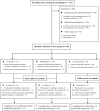Effect of blood flow-restrictive resistance training on metabolic disorder and body composition in older adults with type 2 diabetes: a randomized controlled study
- PMID: 38904038
- PMCID: PMC11186980
- DOI: 10.3389/fendo.2024.1409267
Effect of blood flow-restrictive resistance training on metabolic disorder and body composition in older adults with type 2 diabetes: a randomized controlled study
Abstract
Introduction: To explore whether blood flow-restrictive resistance exercise (BFRE) can be used as an alternative strategy to moderate-intensity resistance training (RT) to improve metabolic disorder and body composition in older adults with type 2 diabetes (T2DM).
Methods: This is a single-blind, randomized, controlled trial. Ninety-eight older adults with T2DM were randomly divided into three groups: BFRE group (n = 34), RT group (n = 31) and control group (n = 33). Two exercise groups received supervised collective training for a period of six months, each lasting 50 min, three times a week. The primary outcomes included fasting plasma glucose (FPG), Glycosylated hemoglobin (HbA1c), blood lipids, blood pressure, and body composition. The secondary outcome was muscle performance.
Results: After six months of intervention, the FPG, HbA1c, blood lipids, diastolic blood pressure, body composition, and muscle performance of the two exercise groups were significantly improved relative to the control group and baseline measurements (P < 0.05). There was no significant increase in lean mass between the two exercise groups compared to the control group and baseline (p > 0.05). There was no significant decrease in systolic blood pressure between the two exercise groups compared to the control group (p > 0.05), but it was significantly lower than their baseline (P < 0.05). There was no significant difference in all indicators between the two exercise groups at the baseline, third and sixth months of intervention (p > 0.05).
Discussion: BFRE can safely and effectively improve the metabolic disorder and body composition of older adults with T2DM. For elderly exercise beginners, BFRE can be used as an alternative strategy to moderate-intensity resistance training.
Clinical trial registration: https://www.chictr.org.cn/showproj.html?proj=178886, identifier ChiCTR2300074357.
Keywords: blood flow-restrictive resistance exercise; body composition; metabolic disorders; older adults; type 2 diabetes.
Copyright © 2024 Ma, Ai, Lei, Tang, Li, Huang, Zhan, Mao, Wang, Lei, Yi, Yang, Yin, He, Zhou and Ruan.
Conflict of interest statement
The authors declare that the research was conducted in the absence of any commercial or financial relationships that could be construed as a potential conflict of interest.
Figures
References
-
- China . Clinical guidelines for prevention and treatment of type 2 diabetes mellitus in the elderly in China (2022 edition). Chin J Intern Med. (2022) 30:2–51. - PubMed
-
- Kobayashi Y, Long J, Dan S, Johannsen NM, Talamoa R, Raghuram S, et al. . Strength training is more effective than aerobic exercise for improving glycaemic control and body composition in people with normal-weight type 2 diabetes: a randomised controlled trial. Diabetologia. (2023) 66:1897–907. doi: 10.1007/s00125-023-05958-9 - DOI - PMC - PubMed
Publication types
MeSH terms
Substances
LinkOut - more resources
Full Text Sources
Medical


